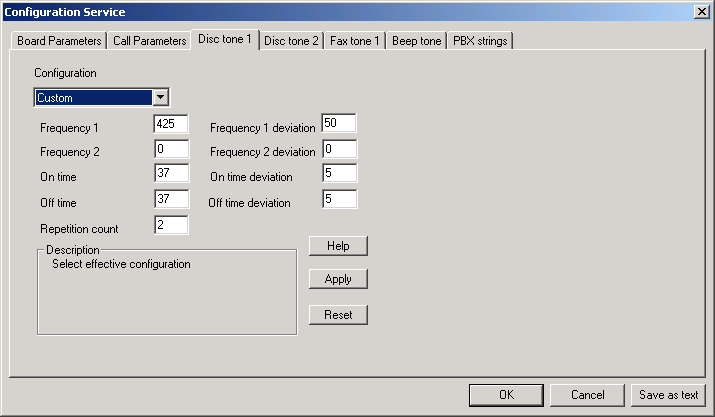Disconnection (End of call digital signaling) Detection
Analog Telephony Cards (eg: Dialogic D/4PCI, D/120JCT
etc) end of call is detectable by:
- Loop Current Drop on the line.
- Disconnect tone on the line.
- Special DTMF tone played by PBX/Switch.
Detection Method Description
Loop Current Drop:
Loop current drop is used by many telephone companies and
PBXs to indicate end of call (other party has hung up).
Please note that based on your phone company a loop current
drop can be delayed. It can arrive several seconds after
caller has hung up.
Disconnect Tone:
Telephone companies will usually play a tone on the line to indicate end of
call, this tone is known as a 'busy tone' or a 'disconnect tone'. PBXs can be configured to play a tone, or send a DTMF
tone (usually tone "D") to indicate end of
call.
Detection of disconnect tones: Voice modems
come pre-programmed with sets tones that they will detect as 'end-of-call' tones
- these cannot be change . Some voice modems detect end-of-call tones well, but
some do not. Telephony cards also come pre-programmed with sets tones that they
will detect as 'end-of-call' tones, but can also be be programmed what disconnect tones to listen
for. This allows telephony card to have its end-of-call (disconnect) tone
detection matched to that generated by the telephone company or PBX.
For Dialogic the disconnect tones to listen for can be configured in the
Dialogic TSP, eg:

To find out the frequencies of the disconnect tone just
record it using "Wave" Demo sample to record
the wave file (just use ITAPICall.Record() start recording
then hang up) and then analyze the frequencies using
any of the more advanced sound editors eg: Audacity (http://audacity.sourceforge.net/)
has a View->Plot Spectrum menu. Note: Please reboot
your system after the configure.
Another way to configure Dialoigc cards to detect busy/disconnect tones is to
create a "Tone File" using Dialogic's
PBXpert application and then selected as the TSFFileName in Dialogic
Configuration Manager (need to set TsFFileSupport to "Yes" as well).
Accuracy of tone detection with telephony cards is much better then with modems.
Some modems even falsely detect disconnect tones while playing/recording sound
files or when a DTMF key is pressed by the caller.
|
 Telephony
Programming Controls
Telephony
Programming Controls 
 Telephony
Programming Controls
Telephony
Programming Controls